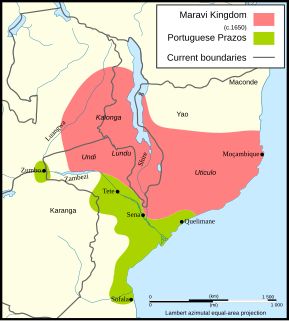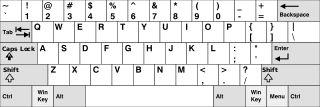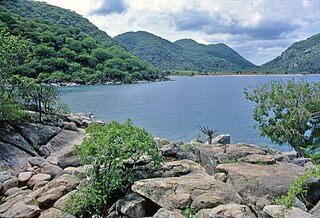
Zambia, officially the Republic of Zambia is a landlocked country at the crossroads of Central, Southern and East Africa, although it is typically referred to as being in Southern Africa at its most central point. Its neighbours are the Democratic Republic of the Congo to the north, Tanzania to the north-east, Malawi to the east, Mozambique to the southeast, Zimbabwe and Botswana to the south, Namibia to the southwest, and Angola to the west. The capital city of Zambia is Lusaka, located in the south-central part of Zambia. The population is concentrated mainly around Lusaka in the south and the Copperbelt Province to the north, the core economic hubs of the country.

The Miombo woodland is a tropical and subtropical grasslands, savannas, and shrublands biome. It includes four woodland savanna ecoregions characterized by the dominant presence of Brachystegia and Julbernardia species of trees, and has a range of climates ranging from humid to semi-arid, and tropical to subtropical or even temperate. The trees characteristically shed their leaves for a short period in the dry season to reduce water loss, and produce a flush of new leaves just before the onset of the rainy season with rich gold and red colours masking the underlying chlorophyll, reminiscent of temperate autumn colours in the temperate zone.

Maravi was a kingdom which straddled the current borders of Malawi, Mozambique, and Zambia, in the 16th century. The present-day name "Maláŵi" is said to derive from the Chewa word "malaŵí", which means "flames".
Tonga is a Pacific Island nation whose people are known as Tongans.
Northern Ndebele, also called Ndebele, isiNdebele, Zimbabwean Ndebele or North Ndebele,. Associated with the term Matabele, is a Bantu language spoken by the Northern Ndebele people which belongs to the Nguni group of languages.

Peri-peri is a cultivar of Capsicum frutescens from the malagueta pepper. It was originally produced by Portuguese explorers in Portugal's former Southern African territories, particularly Mozambique and its border regions with South Africa, and then spread to other Portuguese domains.
Tonga (Chitonga), also known as Zambezi, is a Bantu language primarily spoken by the Tonga people (Batonga) who live mainly in the Southern and Western provinces of Zambia, and in northern Zimbabwe, with a few in Mozambique. The language is also spoken by the Iwe, Toka and Leya people, and perhaps by the Kafwe Twa, as well as many bilingual Zambians and Zimbabweans. In Zambia Chitonga is taught in schools as first language in the whole of Southern Province, and parts of Lusaka and Central Provinces.
Siavonga is a town in the Southern Province of Zambia, lying on the north shore of Lake Kariba. It is Zambia's principal tourism centre for the lake, with accommodation, boating and fishing tours on offer.
The Tonga are an ethnic group living in northern Malawi on the shores of Lake Malawi in Nkhata Bay and northern part of Nkhotakota. They are to be distinguished from the Tonga people of Zambia and Zimbabwe, whose language belongs to a different branch of the Bantu family.

The Tonga people of Zambia and Zimbabwe are a Bantu ethnic group of southern Zambia and neighbouring northern Zimbabwe, and to a lesser extent, in Mozambique. They are related to the Batoka who are part of the Tokaleya people in the same area, but not to the Tonga people of Malawi. In southern Zambia they are patrons of the Kafue Twa. They differ culturally and linguistically from the Tsonga people of South Africa and southern Mozambique.
Yao is a Bantu language in Africa with approximately two million speakers in Malawi, and half a million each in Tanzania and Mozambique. There are also some speakers in Zambia. In Malawi, the main dialect is Mangochi, mostly spoken around Lake Malawi. In Mozambique, the main dialects are Makale and Massaninga. The language has also gone by several other names in English, including chiYao or ciYao, Achawa, Adsawa, Adsoa, Ajawa, Ayawa, Ayo, Ayao, Djao, Haiao, Hiao, Hyao, Jao, Veiao, and waJao.

Many languages are spoken, or historically have been spoken, in Zimbabwe. Since the adoption of its 2013 Constitution, Zimbabwe has 16 official languages, namely Chewa, Chibarwe, English, Kalanga, Koisan, Nambya, Ndau, Ndebele, Shangani, Shona, sign language, Sotho, Tonga, Tswana, Venda, Xhosa. The country's main languages are Shona, spoken by over 70% of the population, and Ndebele, spoken by roughly 20%. English is the country's lingua franca, used in government and business and as the main medium of instruction in schools. English is the first language of most white Zimbabweans, and is the second language of a majority of black Zimbabweans. Historically, a minority of white Zimbabweans spoke Afrikaans, Greek, Italian, Polish, and Portuguese, among other languages, while Gujarati and Hindi could be found amongst the country's Indian population. Deaf Zimbabweans commonly use one of several varieties of Zimbabwean Sign Language, with some using American Sign Language. Zimbabwean language data is based on estimates, as Zimbabwe has never conducted a census that enumerated people by language.
The Southern Bantu languages are a large group of Bantu languages, largely validated in Janson (1991/92). They are nearly synonymous with Guthrie's Bantu zone S, apart from the exclusion of Shona and the inclusion of Makhuwa. They include all of the major Bantu languages of South Africa, Botswana, Lesotho, Eswatini, and Mozambique, with outliers such as Lozi in Zambia and Namibia, and Ngoni in Zambia, Tanzania and Malawi.
Fipa is a Bantu language of Tanzania. It is spoken by the Fipa people, who live on the Ufipa plateau in the Rukwa Region of South West Tanzania between Lake Tanganyika and Lake Rukwa. The ethnic group of the Fipa people is larger than the group of Fipa language speakers. On the Tanzanian side, people who speak Mambwe-Lungu may identify as Fipa and consider their language to be a dialect of Fipa. Lungu and Mambwe are also spoken in Zambia where they are considered languages and their speakers are considered to be ethnic groups in their own right, although linguists consider Lungu and Mambwe to be dialects of a single language. There are three dialects: Milanzi, Kwa (Ichikwa) and Nkansi.

Tonga is a Bantu language spoken mainly in the Nkhata Bay District of Malawi. The number of speakers is estimated to be 170,000. According to the Mdawuku wa Atonga (MWATO) there are also significant numbers of speakers living elsewhere in Malawi and in neighbouring countries.
Ngoni is a Bantu language of Zambia, Tanzania, and Mozambique. There is a 'hard break' across the Tanzanian–Mozambican border, with marginal mutual intelligibility. It is one of several languages of the Ngoni people, who descend from the Nguni people of southern Africa, and the language is a member of the Nguni subgroup, with the variety spoken in Malawi sometimes referred to as a dialect of Zulu. Other languages spoken by the Ngoni may also be referred to as "Chingoni"; many Ngoni in Malawi, for instance, speak Chewa, and other Ngoni speak Tumbuka or Nsenga.

Southeast Africa or Southeastern Africa is an African region that is intermediate between East Africa and Southern Africa. It comprises the countries Botswana, Burundi, Eswatini, Kenya, Lesotho, Malawi, Mozambique, Tanzania, South Africa, Uganda, Zambia and Zimbabwe in the mainland, with the island-nations of Madagascar, Mauritius, Reunion, Comoros, and Mayotte also included.
Joan Hazel Carter was a British-American linguist, known in particular for her work on the Bantu languages, Shona, Kongo and Tonga.
Malipenga is an African dance music of the Tonga people of Malawi. The dance was originated in imitations of military drills when they fought alongside the British Army in World War I.







